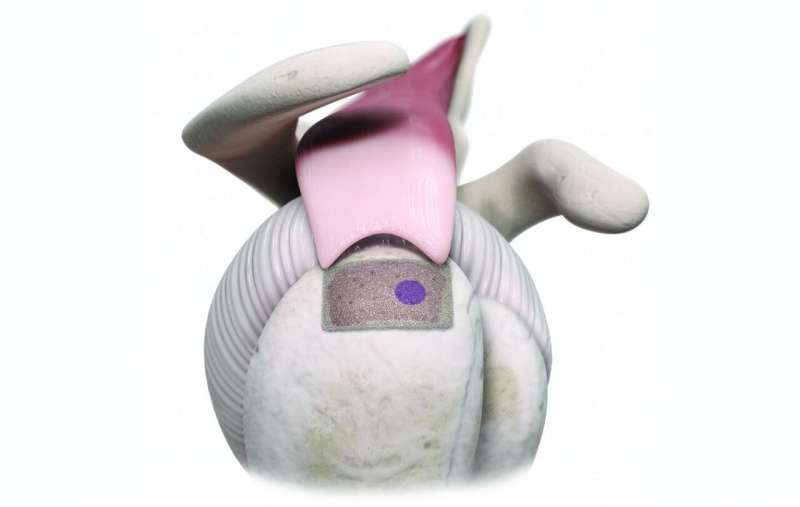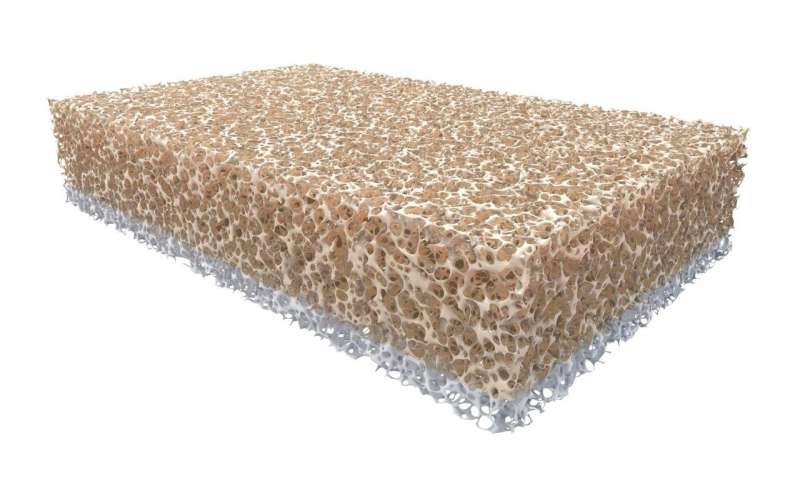
For sports fans, nothing beats seeing their favorite athletes compete at the top of their game. But a shoulder injury such as a badly torn rotator cuff threatens to pause or end the career of any athlete in sports ranging from football, basketball and baseball to golf and tennis.
Athletes sidelined with such an injury could benefit from a new tissue implant on the market invented at Purdue University. The implant has the potential to significantly speed up a patient’s recovery from rotator cuff surgery and offer a more robust repair that is less likely to retear.
The invention is the first implant that can recreate a tissue junction between the tendon and bone, called the enthesis. The ability to recreate the enthesis allows surgeons to more fully restore the natural structure of the joint in a way that hasn’t been possible before.
In March, orthopedic sports medicine company Sparta Biopharma announced that it had brought the Purdue invention to market as BioEnthesis for rotator cuff repair. The first surgeries using BioEnthesis began in February at Rush University Medical Center in Chicago.
The implant could improve outcomes not only for professional athletes but also for people over the age of 60 who are most likely to experience more significant rotator cuff tears that may require surgery.
Recovering from a typical rotator cuff surgery often means weeks of pain and not being able to work or do any activity that involves using a shoulder to reach or pull. Repair for larger tears of the rotator cuff also could have a 50%-90% chance of retearing down the road.

Repairing bone in a part of the joint that couldn’t be repaired before
In a typical joint, tendon and bone meet at an enthesis that is only about a millimeter wide. Within that millimeter, hard, fibrous cartilage transitions into bone.
“The enthesis is an important part of the skeleton because it makes it possible to transmit the enormous forces generated by the muscles during daily activities. Every muscle in a person’s body attaches from tendon to bone through an enthesis,” said Eric Nauman, a Purdue professor of mechanical and biomedical engineering.
Without a way to recreate the enthesis, injuries requiring common surgeries such as rotator cuff repair have taken longer to heal. The bigger the size of the tear that needs to be repaired, the more likely it will retear after surgery. As early as age 30, the rotator cuff starts to weaken.
Since the enthesis is so fundamental to joint movement, BioEnthesis also has the potential to enhance healing for other parts of the body where the enthesis may be injured, such as the Achilles, patellar and quadriceps tendons, Nauman said.
BioEnthesis is a gum strip-sized, sponge-like scaffold made of real human tissue. The implant has two layers: a soft tissue layer to merge with the tendon and a hard tissue layer to allow a patient’s own stem cells to populate the implant from the bone marrow. The bone regrows within the implant to reform the enthesis, effectively repairing the joint.
The implant is compatible with arthroscopic surgery, a procedure typically used for rotator cuff repair.
“Though modern arthroscopic techniques have significantly improved outcomes following rotator cuff repair, there are still unacceptably high levels of retear. The mode of failure is typically related to the tendon not healing adequately to the bone through the enthesis,” said Dr. Adam Yanke, chair of Sparta Biopharma’s scientific medical advisory board and an assistant professor at Midwest Orthopedics at Rush, who performed the first surgery using BioEnthesis. “Approaches to improving the tendon-to-bone healing such as scaffolds and biologics are likely to improve these structural failure rates.”
Sparta Biopharma plans to generate clinical data validating that BioEnthesis accelerates healing and improves retear rates for rotator cuff repair.
Inventing a way to rebuild where soft and hard tissue meet in the body
In 2004, Nauman and then-Purdue graduate student Darryl Dickerson met to discuss an unsolved challenge in tissue engineering: attaching tendon to bone.
“We had figured out how to recreate a major part of ligaments and tendons, but we didn’t have a good way to attach that soft tissue to the bone. Attachment to the bone is critical for the structure to be able to perform,” said Dickerson, who is now an assistant professor of mechanical and materials engineering at Florida International University.
Nine years later, Dickerson and Nauman published a paper demonstrating how a prototype of what is now BioEnthesis successfully reformed the enthesis in the rotator cuffs of animal models. The study showed that the approach allows the rotator cuff to heal itself over time.
The team began collaborating with Sparta Biopharma in 2018 to continue the development of the technology and bring it to market. Purdue Research Foundation’s Office of Technology Commercialization has numerous pending and issued patents covering the implant.
“It is incredible to see many years of research, design and development work translate into positive impact in people’s health and lives. The success of BioEnthesis for this very challenging orthopedic repair offers insight that will enable future clinical breakthroughs,” Dickerson said.
Source: Read Full Article
